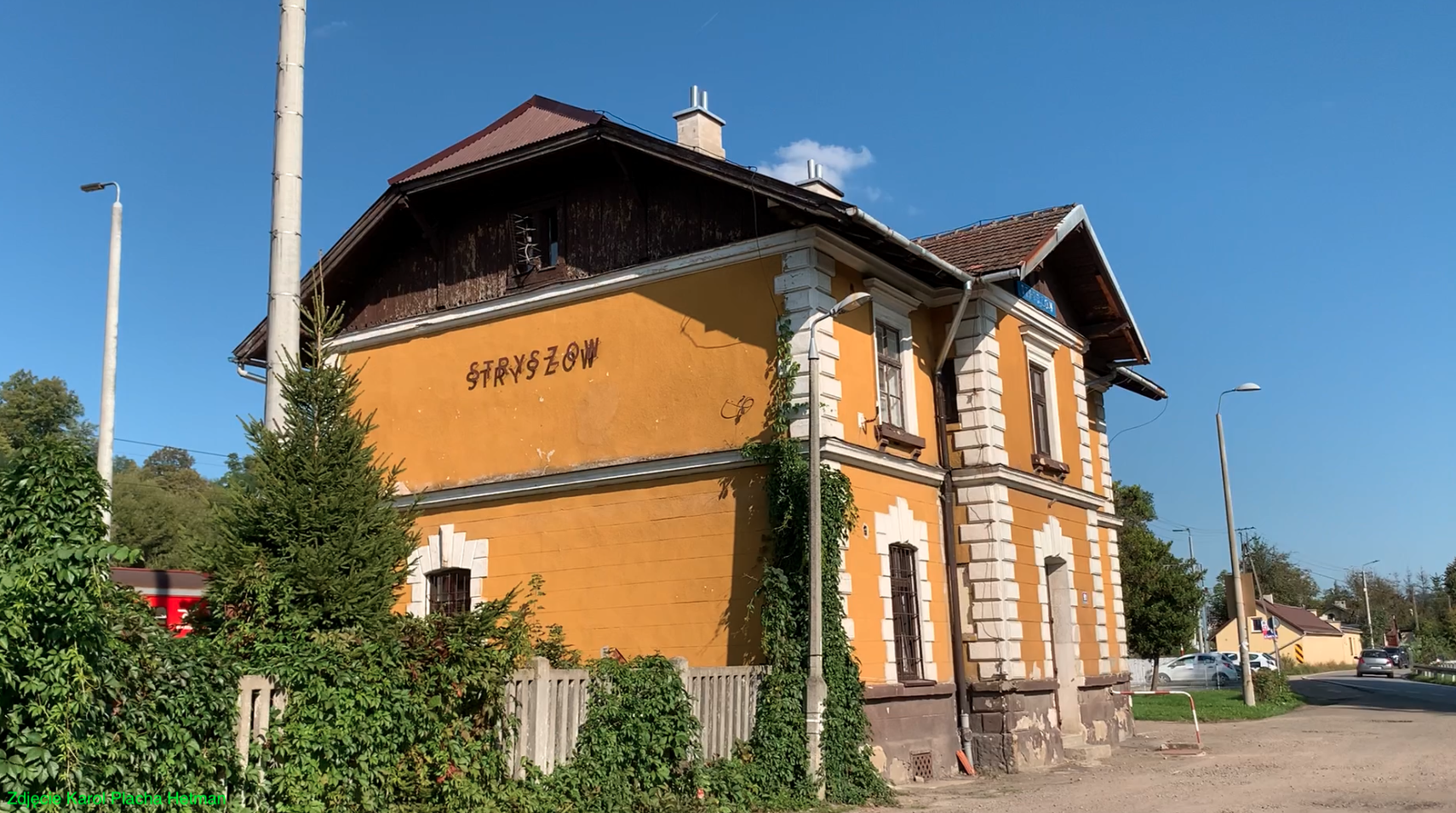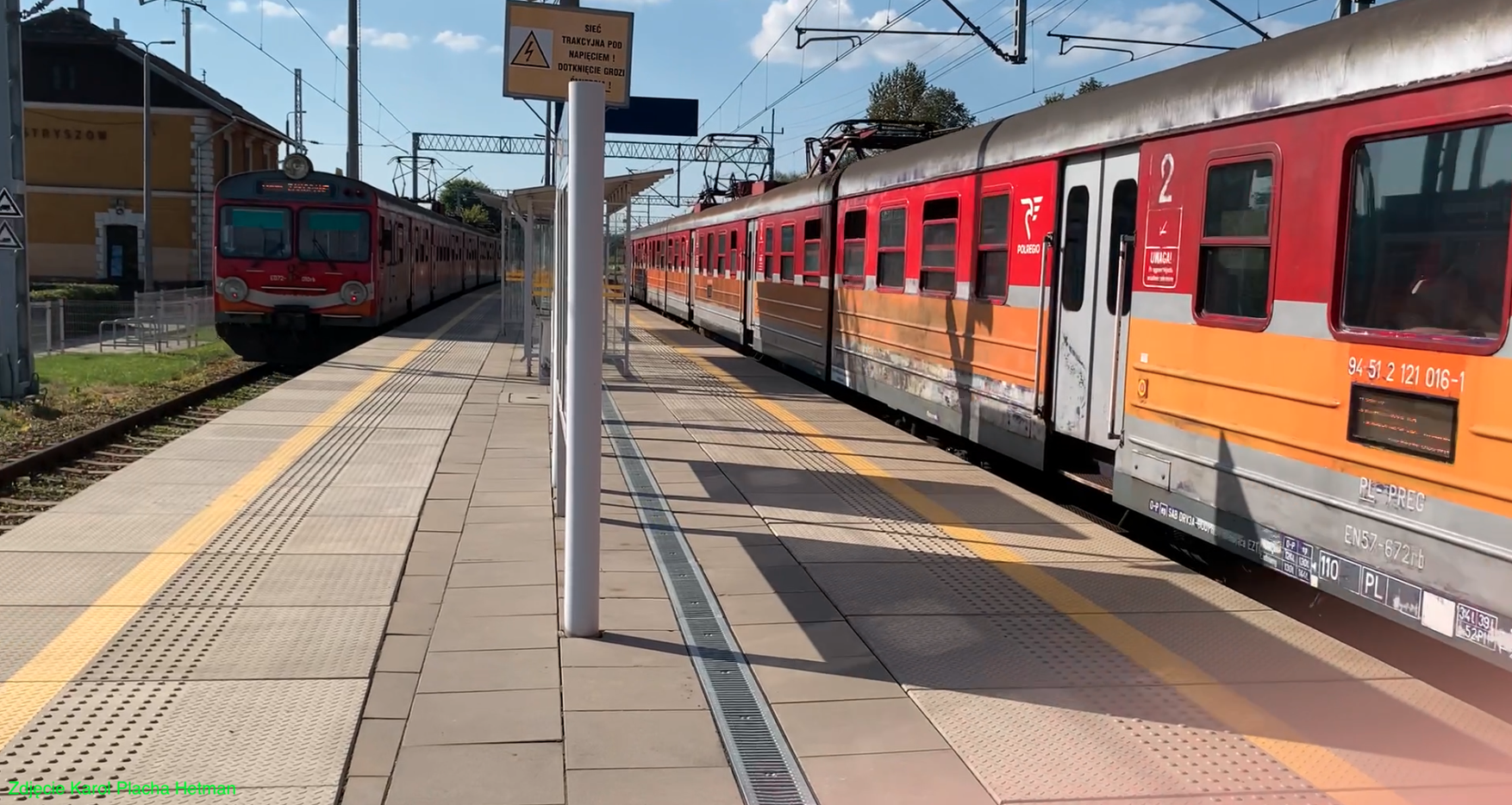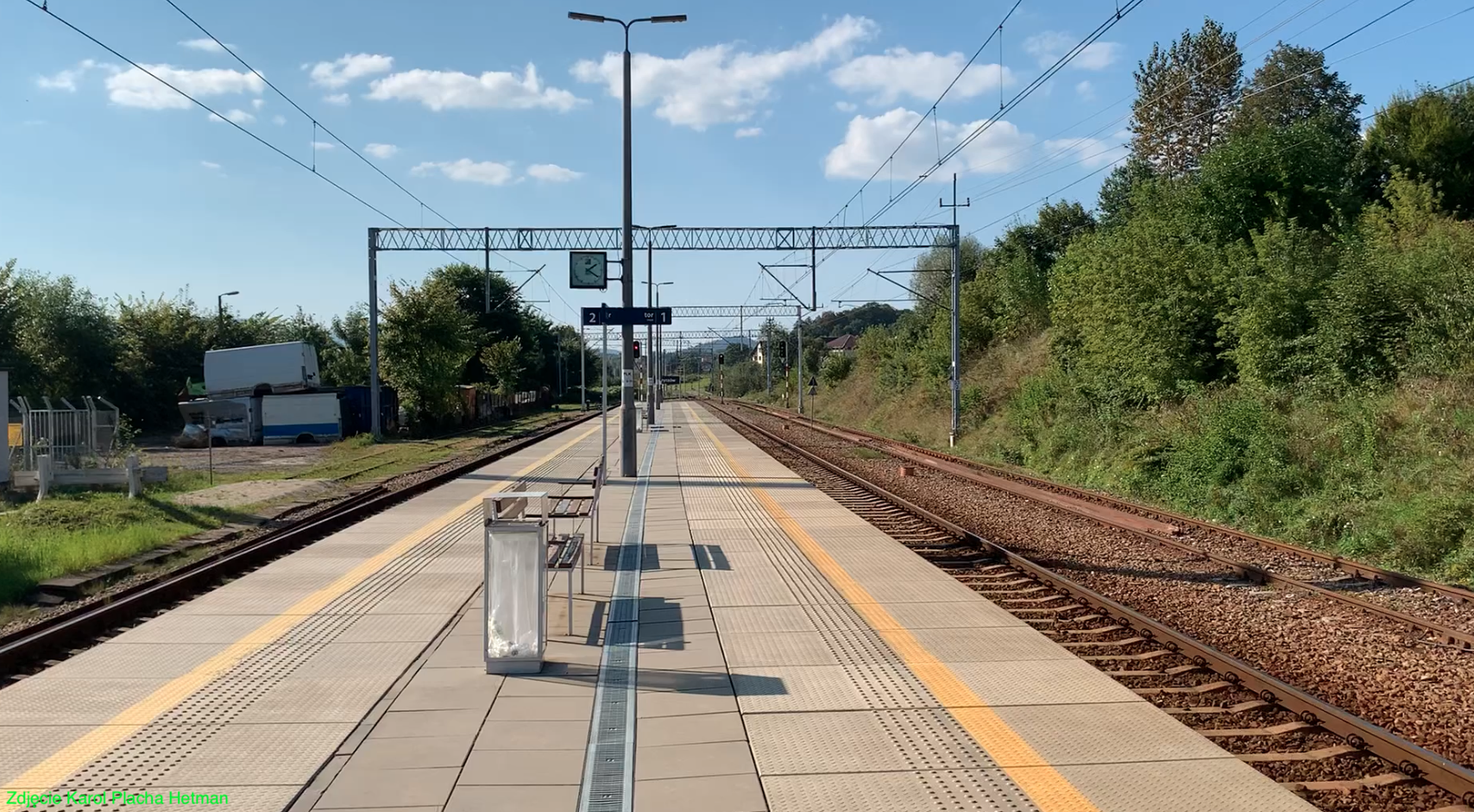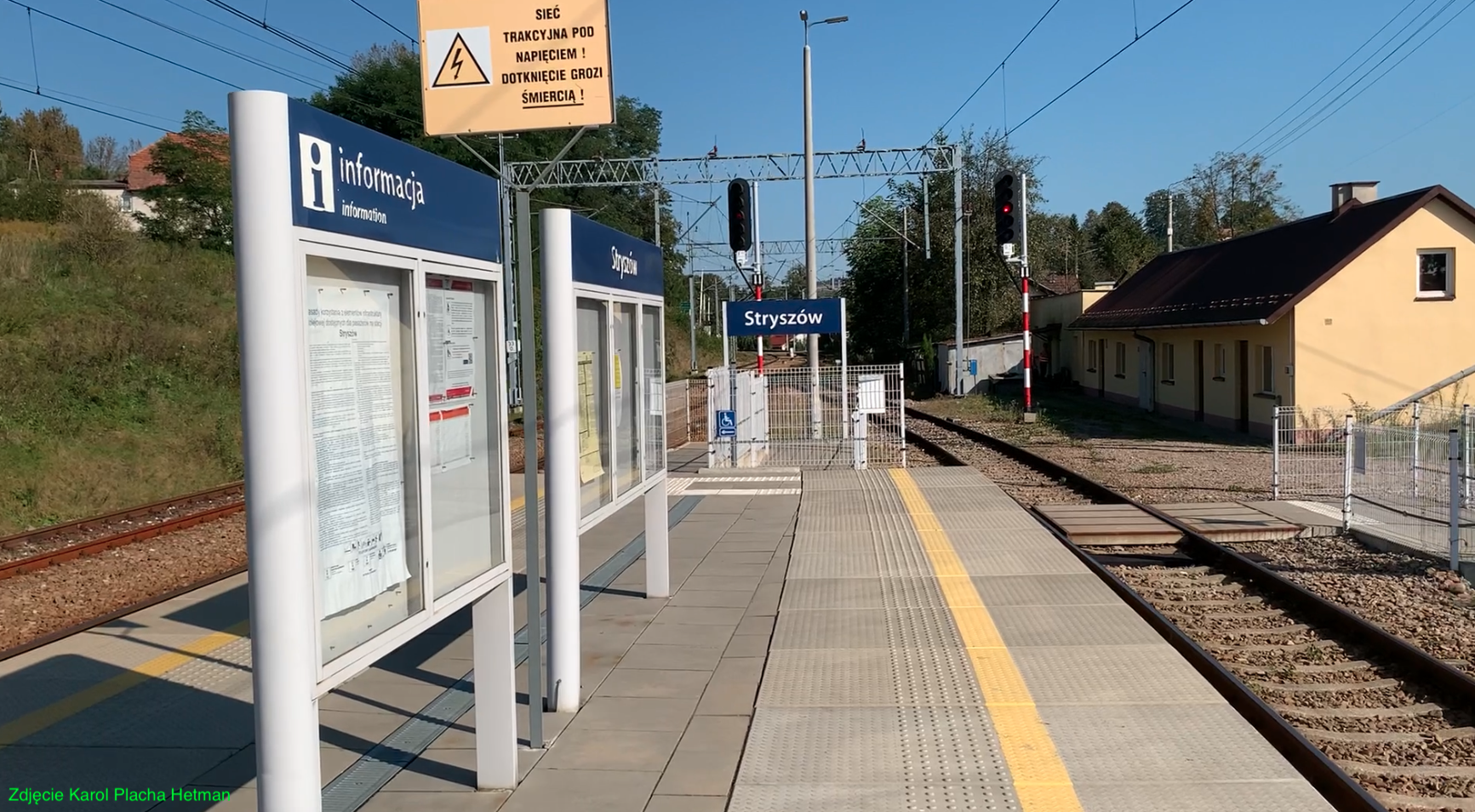Kalwaria Zebrzydowska 2023-10-09
Stryszów railway station near Kalwaria Zebrzydowska.
Geographic coordinates: 49.825N 19.622E. Elevation 340 m.





The town of Stryszów.
Stryszów is a small town in the Beskid Mountains, between Kalwaria Zebrzydowska and Sucha Beskidzka. Stryszów is located in the Wieliczka Foothills, in the Beskid Makowski Range, in a small valley at the foot of the forested Chełm Mountain (603 m above sea level). The Stryszów commune consists of six villages: Dąbrówka, Leśnica, Łękawica, Stronia, Zakrzów, Stryszów. Stryszów is located in the Lesser Poland Voivodeship, in Wadowice County. A district road runs through the town.
According to tradition, the name Stryszów comes from the word "Strychacz", meaning brickmaker, because there were brickyards and pottery factories in these areas. In 1326, the first mention of the town appeared. Stryszów was a private property of the nobility, belonging to various families, until September 1, 1939. The last owners were Rozalia and Franciszek Łubieński. A farm and then a manor were built in Stryszów. The manor was built at the end of the 16th century. Currently, the manor houses a museum. The parish was established at the end of the 15th century. A wooden Catholic Church dedicated to Saint Nicholas was built. In 1739, the wooden church burned down, and a new brick one was built in 1742. In 1747, the church was consecrated. This fire destroyed not only the church, but also partially the manor house and many peasant farms. In 1860, the construction of a wooden school and a house for the teacher began.
During the Second Polish Republic, she operated in Stryszów; a match factory, a dairy, a water mill, three inns, a railway station, and the "Kasa Stefczyka" bank. During World War II, the Germans banned the operation of the mill, and anyone who started it could be sent to a concentration camp. The mill only worked at night and thanks to this, people had some flour. The first Polish Post Office was opened in February 1945. In 1946, the farm land was divided among local farmers. In the period 1975–1998, the town belonged to the Bielsko Voivodeship. In 2008, the village of Stryszów had approximately 2,100 inhabitants.
Currently (2023) in Stryszów there is; railway station, primary school, Polish Post Office, Volunteer Fire Department, Health Center, Catholic Church of Saint John Cantius, Manor House in Stryszów with a museum. Dwór Stryszów: address Stryszów 508, 34-146 Stryszów. The manor was built at the end of the 16th century as a residential and defensive watchtower. After a fire in 1739, it was rebuilt. The attraction of the manor is the permanent exhibition of the interior of a Polish manor from the 19th century.
Railway line No. 97 Skawina - Żywiec.
Railway line No. 97 Skawina - Żywiec runs through the Stryszów station. The station is on line 33,110. The line was put into operation on December 22, 1884. From the very beginning, the line was 1,435 mm standard gauge. The railway line No. 97 Skawina - Żywiec is 82.708 km long. The permissible speed is 100 km/h. The line is electrified with a 3kV DC traction network. Electrification was carried out in stages; July 17, 1974 (Skawina - Sucha Beskidzka), September 29, 1983 (Sucha Beskidzka - Lachowice), October 26, 1989 (Lachowice - Żywiec). The traction network is of the C120-2C type and is adapted, depending on the section, to a maximum speed of up to 110 km/h; current carrying capacity is 1,725 A. The line is single-track. The line was built as part of the Galician Transversal Railway when the Republic of Poland was under partition. In the 1960s, the line was equipped with the SHP system. There are traffic lights on the line.
Due to the construction of the water reservoir in Świnna Poręba in the period March 10, 2014 - December 15, 2014, part of the railway line was postponed on a section of 34,100 km - 43,078 km. The railway track from Stryszów to Sucha Beskidzka runs on a new hydrotechnical embankment and along the crown of the water reservoir. Two bridges were built on the new route equipped with overhead contact lines. In Dąbrówka, on the Stryszawka River, a 4-span, 234-meter-long crossing, 27 meters high, was built. A seven-span, 400 m long bridge was also built over the Skawa River in Zembrzyce. The bridge is an arch structure, set on 24 m high supports. In addition to the two railway bridges, there was also one road bridge in the town of Dąbrówka and a car road in the area of Zembrzyce and Stryszów. The road bridge is 234 m long, 14.5 m wide and has a maximum height of 28 m. The bridge is built of 4 spans, each 56.7 m long. The bridge's supporting system is suspended from reinforced concrete arches using rod hangers. A new road runs over the bridge; Stryszów - Zembrzyce, 5.4 km long and 6 m wide road.
On December 12, 2014, the ceremonial opening of the railway line on the Stryszów-Zembrzyce section took place. The investment was carried out by Skanska, commissioned by the Regional Water Management Board in Krakow. The project was completed 6 months ahead of schedule. The value of the task is nearly PLN 170 million net.
In March 2023, the construction of a new passenger stop on railway line No. 97 at Lake Mucharskie in Dąbrówka began. In the period 2014-2022, traffic on line No. 97 was interrupted and resumed several times due to subsequent stages of renovation works.
Water reservoir in Świnna Poręba.
The water reservoir in Świnna Poręba is an investment whose construction began in 1986. The investor was the Regional Water Management Board in Krakow. The reservoir is located in the Lesser Poland Voivodeship, in the Wadowice and Suski counties, in the communes of Mucharz, Stryszów and Zembrzyce. The reservoir stretches from Świnna Poręba to Zembrzyce for a distance of 11 km. It has a capacity of over 160 million m3 and an area of 1,350 hectares. The reservoir passed its first test during the flood in 2010, receiving over 60 million m3 of water and thus reducing the flood wave on the Vistula River that passed through Kraków.
Stryszów railway station.
The Stryszów railway station was opened in 1884. The first train passed through Stryszów on December 16, 1884. The station was built in 1886, in the Austro-Hungarian style, as a two-story building with a hipped roof. There is a ticket and baggage counter and a waiting room at the station. There was no restaurant because there was an inn nearby.
In 2011, the ruling Freemasonry in Poland handed the station over to the Stryszów Commune. This was another step towards the liquidation of railways in Poland. The commune itself was not interested in the station, warehouse and part of the tracks. It is difficult to estimate the value of this property because there were no appraisal reports. In 2014, after the change of government in Poland, the property returned to PLK PKP.
In the period 2014-2016, the station was last rebuilt. The track system was left, but the tracks were replaced; trackbed, sleepers, rails. The island platform, which was a low type, was completely rebuilt. This platform had an asphalt surface with white warning and edge lines painted on it. There were two bus shelters on the platform, painted blue. The shelters only protected passengers from rain or snow. There were benches under the shelters. Access to the platform was at track level, at the level of the station building. The platform was lit by street lamps with concrete pillars.
As a result of the renovation, the wooden sleepers were replaced with pre-stressed concrete sleepers. The contact rails were replaced with contactless ones. Screw fastenings were replaced with spring fastenings. The entire catenary network was replaced. Culverts have been renovated. Renovation was also carried out at the rail-road crossing in the eastern head of the station. The new, high platform is 200 m long. At the platform edge there are concrete slabs with a yellow warning line and buttons. The width of the slabs is 1 m. The rest of the platform surface is paved with paving tiles. Four bus shelters with benches and resting areas have been installed on the platform, which also protect passengers from the wind. On the platform there are railway information boards, a sound system for railway announcements, waste bins, lighting and additional benches. The access to the platform is located on the eastern side of the platform and is accessible to passengers in wheelchairs. The walkway leading to the platform is fenced and ensures the safety of passengers.
According to the PKP classification, the station has the category of a local station. Currently (2023), the station serves up to 50 passengers per day. Currently, from Stryszów you can get to: Kraków, Zakopane, Sucha Beskidzka. In October 2023, 34 PolRegio trains passed through the station. Usually these were EN57 or ED72 trains. The layout of the station allows for trains from opposite directions to pass each other here. There are three tracks running through the station; two at the platform, one track from the north to hold a freight train with a fin to the western sections. There is also a freight siding on the south side with entry/exit from the west.
Written by Karol Placha Hetman
